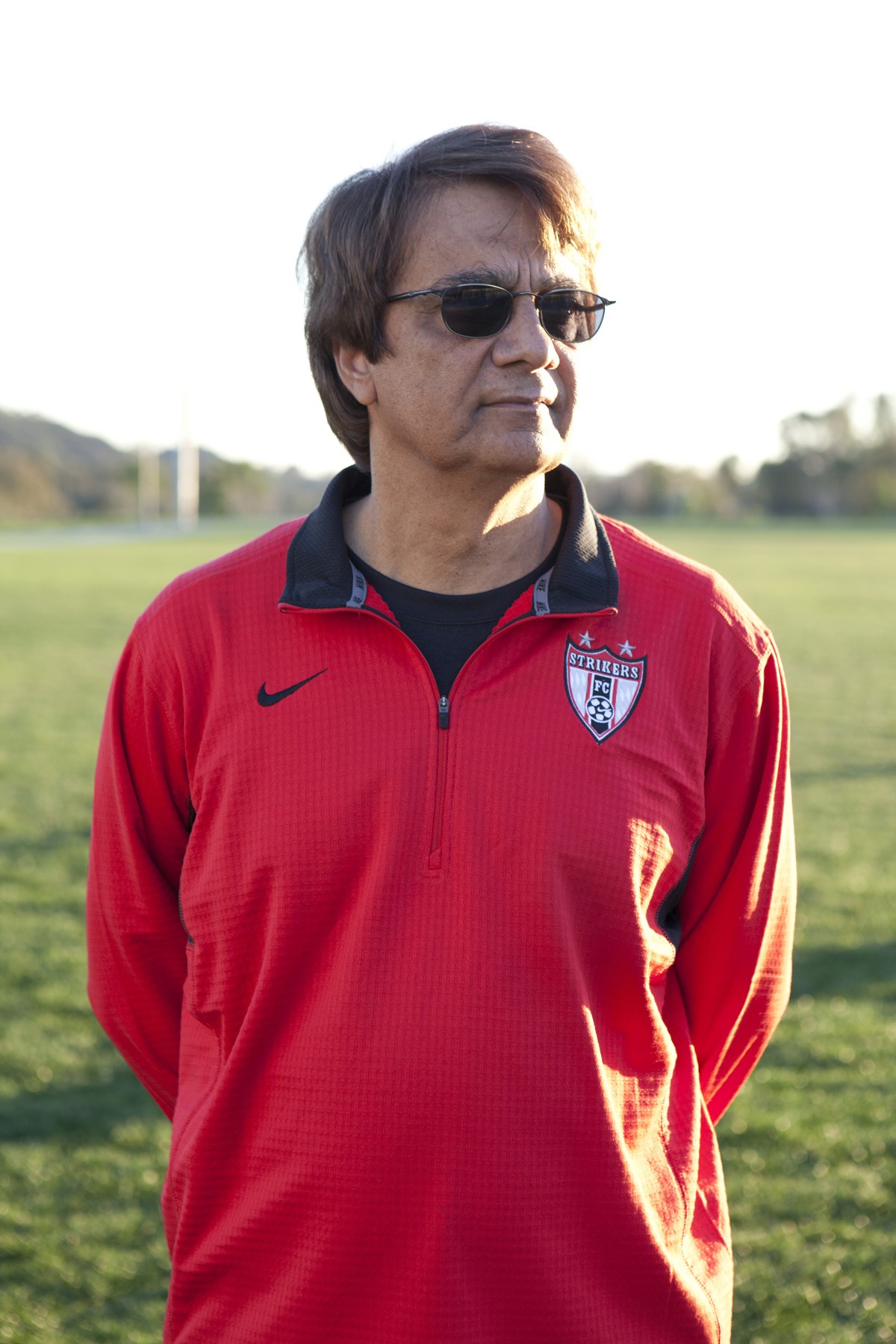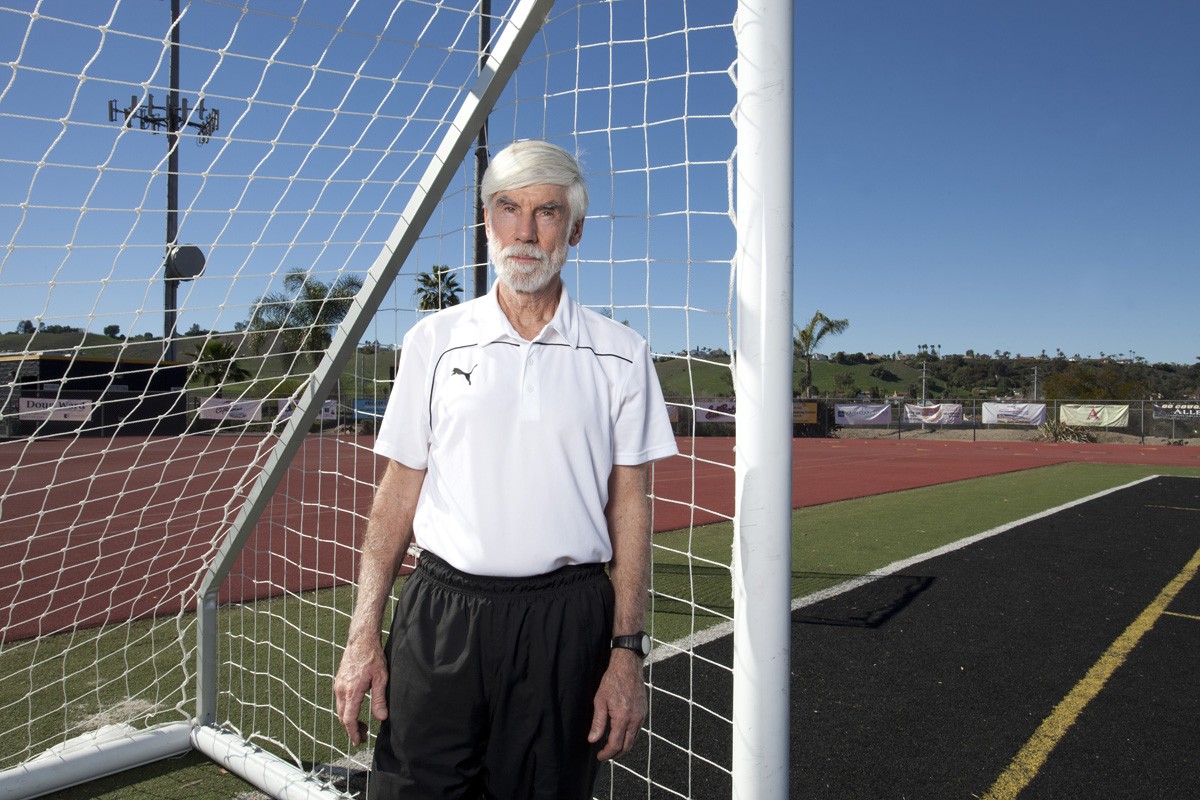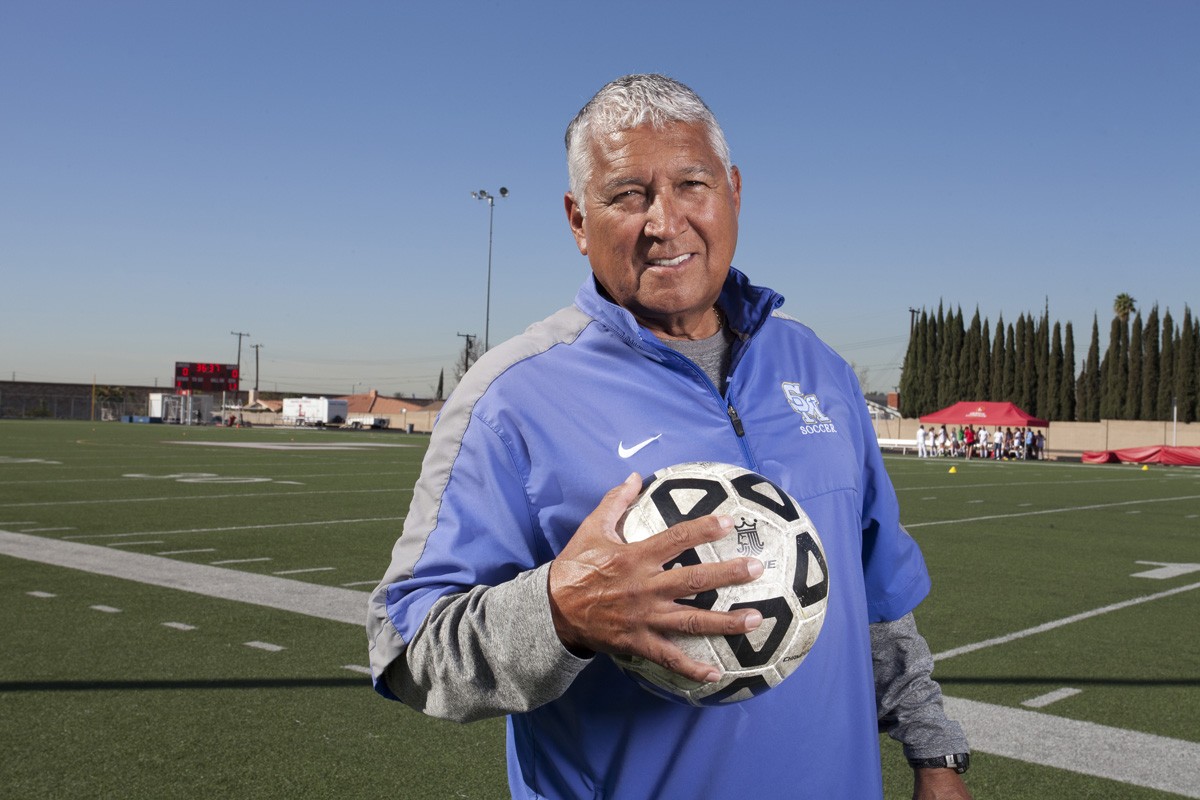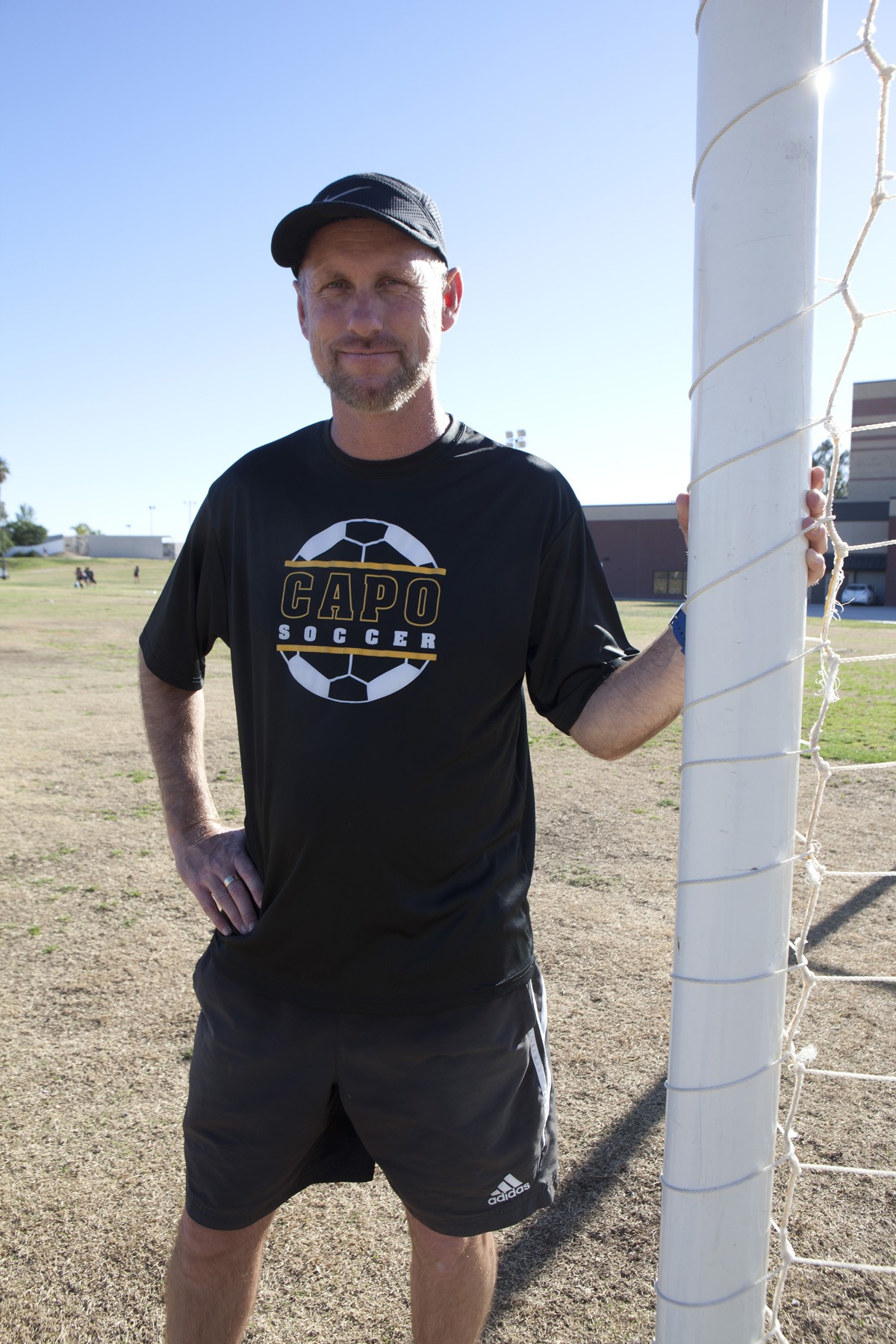
It’s 48 degrees on a recent Wednesday night at Lake Forest Sports Park, and soccer balls are flying everywhere. Teams pack every inch of grass under the glowing stadium lights, while parents, bundled in jackets and hats against the cold, huddle in groups on the sidelines. Amidst the blur of activity on the field is a serene figure dressed in a dark-blue sweat suit with his hands wrapped in gloves behind his back. Abner Rogers, the president and founder of Strikers Futbol Club (FC), one of Orange County’s top-tier soccer clubs, paces quietly—a characteristic of his coaching style—along the perimeter of a coned-off 28-yard-by-16-yard grid, watching the movement and passes of his 18-player squad of 12- and 13-year-old girls.
“Open up!” Rogers tells the young Strikers team, reminding them not to overcrowd the middle of the field. A few players backpedal in response, creating open space for the ball to be played. Rogers continues around the cone-lined perimeter, silently measuring the movement of his players in relation to the ball.
A girl loudly calls for a pass and collects it flawlessly, as if there were Velcro on the side of her foot. With bursting speed, she dribbles into the open space created by her teammates. She sees another one of her teammates streaking down the sideline of the grid, and with precision, she sends a perfectly timed pass between two defenders. The ball lands on target.
“That’s a great pass!” Rogers shouts.

Although a skilled bunch, Rogers’ Strikers is among the many talented young soccer squads in Orange County, which has become a hotbed for world-class talent in recent years. But unless you’ve had firsthand experience with local soccer or keep up with women’s professional teams, you probably wouldn’t know OC has directly affected women’s soccer on the world stage. And the impact hasn’t been light, either. At least three to six players from here have made the team since the inaugural Women’s World Cup in 1991.
There’s a reason for that: Behind the curtain of gifted female athletes in OC exists a small group of coaches who’ve dedicated their lives to the cultivation of first-class soccer. Through the development of quality clubs, Olympic development programs, nationally acclaimed high-school programs and semi-pro leagues, these coaches have had their hands heavily involved in the development of players, becoming the link between Orange County and world-stage soccer.
“Today, there is an under-14 [years of age] U.S. Women’s National team to an under-23 national team,” says Tad Bobak, the program director for SoCal Blues, one of OC’s powerhouse soccer clubs. “You have multiple levels of national team rosters, and all of them have a good number of players from Southern California. Orange County, in particular.”
* * * * *

With a coaching career spanning almost half a century, Bobak is the sage of OC soccer. He began coaching in 1972, when he moved to California. His Brazilian roots gave him an edge, and Bobak’s perspective on the sport and how it’s played was instantly respected. “It was just AYSO [American Youth Soccer Organization],” he says. “People knew I was from Brazil and played the game. They wanted me to help coach their players.”
Bobak coached club soccer at first and, in 1982, co-founded the Cal-South Olympic Development Program (ODP), which provided a place for gifted female soccer players in Southern California to compete against other technically refined and competitive teams. More important, however, it gave young girls a platform to explore the potential of their athletic aptitude. “I just wanted to give the girls an arena to exercise their God-given talent,” Bobak says.
But Bobak went beyond that. His work in developing the ODP curriculum produced Julie Foudy and Joy Fawcett, two Orange County soccer players who helped the United States win the first Women’s World Cup in 1991. His program initiated the relationship between local and professional soccer.
As the current program director for the SoCal Blues soccer club, he continues to provide an environment for girls to express and develop their talents. “There’s a whole family of us coaches in Orange County who are working together to create a place for world-class talent to develop,” says Bobak. “Our goal is to inspire them, as well as foster their passion.”
Bobak names West Coast Futbol Club, Strikers FC and Slammers FC as some of the most important OC soccer clubs, given their track record in providing girls with an environment to evolve as players. The three clubs are responsible for a handful of national team players, showcasing the success of their club-wide soccer philosophy. But perhaps the most direct link between local and professional soccer is Rogers. His signature zen demeanor and soft-spoken approach to coaching guides and nurtures players in a way that kindles creativity within teams, making him one of the best coaches in the United States.
With encouragement from Bobak, Rogers got involved in the Orange County girls’ soccer scene full-time in 1995, when he became the director of Mission Viejo Soccer Club, which ’91 World Cup winner Julie Foudy came from. “The team was very talented,” says Rogers. “But it was more than just winning; it was about developing the players in hopes to advance them to ODP.”
Rogers’ central focus on the development of players has resulted in dozens of girls advancing to Division I collegiate soccer and the pros. The smart, elegant soccer that Rogers instills in his players opens up a world of possibilities for them, as many of them are scouted for ODP, university teams and national programs.
Lake Forest soccer legend Amy Rodriguez is a prime example. Although graced with athleticism and talent, without Rogers’ guidance, Rodriguez may never have pushed herself to receive multiple All-American awards and the Gatorade Player of the Year award at Santa Margarita Catholic High School (SMCHS). She broke records at USC, where she became one of the university’s leading goal scorers and led her team to an NCAA championship. Before graduating from college, Rodriguez made the Olympic roster for the U.S. Women’s National Team in 2008; in Bejing, she scored goals that were crucial for advancing to the finals and taking home the gold medal.
“It is refreshing to know we have coaches the caliber of Abner Rogers involved in the development of women’s soccer—Southern California is truly fortunate to have him,” says Garrett Smith, the Division I women’s soccer coach at the University of Portland, praising Rogers.
“It’s a very simple but difficult philosophy,” Rogers says, explaining his methodology. Aggressive play, prone to errors, can cost games in the short term, he adds, but it’s key to developing confidence and building team talent. “It gives them many more touches in the long term, allowing for growth. Developing the players is more important than winning.”
With growth comes knowledge, Rogers teaches his players. “Allowing players the freedom to make those mistakes is critical in development,” he says. “If I screamed and yelled at the girls and told them where the ball should go, I would only produce robots. They wouldn’t be able to solve problems on their own.”
* * * * *

Before the Women’s Professional Soccer (WPS) league folded in 2010, Rogers coached the LA Sol and led them to the finals, adding to his impressive list of championship victories. His explosive roster included Brazilian superstar Marta da Silva and Redondo Beach-based Olympic gold medalist Shannon Boxx. Without Rogers’ influence as a coach, it’s possible the United States would lack a lot of the talent it has on the professional level. Much more certain is the fact that, without him, Orange County wouldn’t yield nearly as many profoundly skilled female players.
Beyond private teams, the county is home to some incredible high-school soccer programs, including that of SMCHS.
Chuck Morales, the varsity soccer coach and head of SMCHS girls’ soccer program, has made it his mission to provide an environment for players to thrive in. “Santa Margarita’s soccer program is different because it’s filled with student athletes who want to do well,” he says. “We just provide them with the right tools for success.”
This year will be Morales’ 40th coaching in Orange County. His technique for helping players develop into the powerhouses they’re mean to be is slightly different from Rogers’ in that he begins by training girls on their individual ball skills, passing finesse and field positioning long before they enter high school. “There are several really good trainers and coaches in Orange County, and we work at the grassroots level,” he says. “That’s what the federation and U.S. soccer and all of the soccer minds always say: If you’re going to get anywhere in the game, it has to start at the lowest level—it has to start with the youth.”
Rodriguez’s onetime coach has given the girls within the OC soccer community a platform in one of the most competitive prep leagues in the country: The Serra League. Players often run the risk of losing their sharpness when they join high-school teams because the competition generally doesn’t compare to that of a club. Morales’ program at SMCHS, however, is highly respected by club coaches because he returns players back to their club teams well-trained and in shape.
“I’ve offered my passion for the sport and a place for the girls to express their talents,” says Morales. “But it’s not just me. There are a lot of guys in Orange County who have done the same thing, are just as passionate and do a tremendous job at training girls the right way.”
Morales cites both Bobak and West Coast FC’s Doug Swanson as two of OC’s best soccer coaches. “We’re as good as we are in Orange County because the girls always have the chance to compete against really, really great teams,” says Swanson.
The weather doesn’t hurt, either. “Girls can train year-round here,” he adds. “With such a high population of young girls wanting to play and good weather, you have the makings for a hot spot.”
Swanson credits his success to the fact that he develops talent early and sticks with a core group of players over several years. “Last year, I had a team that won the under-16 National Championship,” he says. “And it was a validation of my developmental style of coaching because I’ve coached the core of that team since they were little.”
One major concept these coaches have in common is that they’d rather lose a game playing fundamentally sound and with elegance than win having played ugly soccer. This shows their deep respect for the game—easy to lose sight of in a high school and club atmosphere that demands trophies above all else.
Neil Powell—who has worked under Rogers and is currently coaching club teams, a high-school team and a semi-pro team—believes that aspiring Orange County soccer players are lucky to live where they do. “It’s competitive, but [coaches here are] all just trying to do the right thing and teach players the right way to play,” he says.

Powell has also provided girls with the opportunity to excel in ways that go beyond the field, helping numerous players in Orange County get into top college programs. “I play a small, small part as a coach,” he says. “But I’ve helped so many girls get into college over the last 10 years that it’s become a part of how I contribute to the game.”
Witnessing the growth of his players over the course of several years is the most rewarding aspect of his job, says Powell. “There are a ton of local girls from OC or who’ve played in OC who have gone on to play professionally,” he says. “Some of them have even won national championships in the pro league.”
Until recently, the options for women to play soccer outside of college were minimal. Many times, girls would lose the technique they worked hard to maintain. “The WPSL is a semi-pro league that has a couple of professional teams in it,” Powell says. “We all get our chance to play them, which is the best way to keep the competition high and maintain well-developed skill sets. It’s a good way to keep the college kids playing in the summers.”
However, the past 15 years has been difficult for the sport. Since 2000, two professional soccer leagues have folded because of a lack of funding. Although a professional women’s soccer league does exist, California doesn’t have a team yet. But, Powell says, there’s talk about an Orange County-based team joining the league next season. “Hopefully, the third time’s the charm,” he says. “Right now, the closest place to Orange County to play professionally is Portland. The word on the street is that there may be a pro team next year here in Orange County. But we still need investors and commitments, so it’s still in the works, although it looks like it should happen.”
Having a professional women’s soccer team based here would solidify the county’s reputation as a global epicenter for the growth of world-class female soccer players. It would also give young players a tangible, real-world example of what happens when you work your ass off. Although the United States Women’s National Team provides that example for youth players, there’s something to be said for watching a team of professionals in person—and in your hometown. It makes it easier to become inspired and feel a connection to the game, which is exactly what coaches want in players—especially when they’re young.
Across the United States, women’s soccer is changing rapidly. Since the ’91 Women’s World Cup, female players on all levels of the game have developed technique and have grown to understand how to play with elegance. Although the U.S. traditionally tends to rely on athletic ability rather than skill when compared to other countries, the country has progressed light years thanks to coaches such as Bobak, Rogers, Morales, Swanson and Powell.
With professional teams on the rise around the country, the future of the women’s game looks competitive, which is exactly what’s needed to remain on top. “The women’s game is evolving across the globe,” says Bobak. “We need to make sure that we stay up with the competition.”
“The rest of the world is fast approaching in terms of technical ability and tactical awareness,” Swanson argues. “You look at the European countries, like Germany and England, and it becomes evident how good the rest of the world is going to become.”
* * * * *

Finishing practice with an abdominal workout, Rogers’ players appear spent. Sweat pours off their brows, and steam, visible in the cold air and stadium lighting, rises from their heads. Several of the young girls yelp as Rogers encourages them to push through the fatigue, to build their mental toughness. As soon as Rogers relents, the girls release a unanimous sigh of relief and some of them immediately lie back on the grass. They take their last jog of the evening and collectively begin cool-down stretches. As they do this, Rogers gives them his feedback regarding the night’s training session.
“What we want to focus on is spacing and angles,” Rogers says. “The more we play, the better we’ll be at judging when to dribble and when to pass the ball.”
He quietly emphasizes the importance of tactics, awareness and playing a game of purposeful possession. “We move the ball around to try and find space,” he explains. His young Strikers switch from hamstring stretches to groin stretches to ankle rolls. “We need to focus on how we are going to utilize the space as a team in order to penetrate the defenders and go to goal.”
The future stars of women’s soccer pack up and leave. Rogers remains on the field, chatting with another coach about the latest professional games he’s seen—a conversation that lasts a full 30 mintues. “It’s very rewarding to work hard,” Rogers says as he finally exits the field. “We’ve experienced this success by not cutting corners.”


